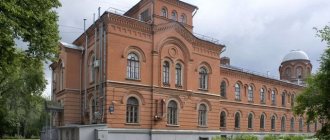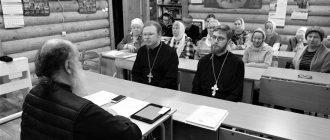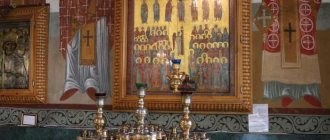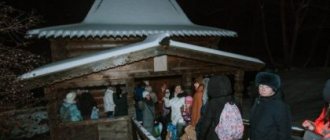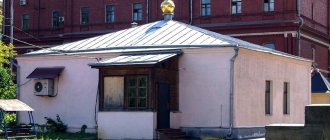The essence of the almshouse
Photo: Cultinfo.ru
In general, a hospice is a nursing home and differs from it not so much in organization as in its internal content. Modern hospices strive to become an abode of the Christian spirit, a place where love reigns in the concept bequeathed to us by the Savior.
It is here, at the end of their days, that people strive for what they did not have time for in their entire lives: to think about their soul, to give them eternal life and salvation. Sooner or later, people are not allowed to know. There is a supreme court over everything that will decide who is worthy of salvation. But it is in the hospice that all conditions have been created for this.
Usually this institution is created in a temple and is located in close proximity to it - this is the second difference from a nursing home.
And formal differences are also observed: here old people are called nuns, mothers. The rooms are cells, the dining room is a refectory.
But the main thing who lives in a hospice is not its manager or the nuns, but the holy Christian spirit, which helps everyone who lives and works in this institution to sooner or later realize what Christian relationships are. What true love is, because what God is.
How almshouses work today - church boarding schools for the elderly and disabled
When a person is assigned to a boarding home for the elderly and disabled, it sounds like a death sentence for him. But there is another way out - almshouses. The Interlocutor correspondent visited the oldest Svyato-Spiridonievskaya.
“We lived on beds, ate on beds”
The three-story almshouse building is easily identified by the cross on the roof. An old mansion stands on the shore of Cherkizovsky Pond. In the distance, the buildings of the Temple of Elijah the Prophet gleam white.
The Holy Spyridonievskaya almshouse is a project of the Orthodox relief service “Mercy”. The founder is the St. Demetrius Sisterhood, the employees are sisters of mercy. These are ordinary Orthodox women who dedicated their lives to caring for the sick and elderly. Sister Ksenia meets us. She does organizational work.
“We’ve only been in this building for 5 years,” she says. – We started very modestly – with two small apartments on Shabolovka. All our residents (in almshouses this is what residents are called. - Author) lived on beds, ate on beds, slept on beds, all manipulations and procedures were done on beds. All life took place in these apartments; there were no ramps or elevators in the building. And here we have a heavenly paradise.
According to Ksenia, the almshouse was located in this building before the revolution. The Patriarchy returned it in our time.
Ksenia // photo: Olga Kuznetsova / “Interlocutor”
“People are going to church themselves”
Ksenia leads us through the “heavenly paradise”. On the ground floor there is a kitchen, a laundry room, and a spacious refectory. It has light, stylish furniture, and it seems like the home of a wealthy family. The smell here is not of cabbage, as often happens in social institutions, but of meat and tasty. The cooks in the kitchen are preparing lunch.
On the second floor, little Yorkie Basya joins our “delegation”. The dog is here for mental therapy.
Ksenia does not allow Basya into the house church - the hall with icons - and closes the entrance to it with a partition. Today there is not a soul here, but on holidays sisters and residents come to services, and singers from the Church of Elijah the Prophet sing. In the almshouse it is not necessary to attend church services and read the prayer book, but...
“All our sisters are Orthodox, and there is such an atmosphere that people become churchgoers themselves,” explains Ksenia.
The fate of a ballerina
The Holy Spyridonievskaya almshouse is not just for the elderly and sick; either very old people or seriously ill people live in it. There are 18 people in total. The nurses are not able to take on milder patients. Although there are situations when relatives ask sisters to take in their grandmother for a month or two while they are on vacation.
“We don’t have a foster care service for grandmothers,” Ksenia jokes.
In order for a person who really needs help to get to the almshouse, his relatives or friends must leave a petition in the temple of Tsarevich Demetrius or on the Mercy website. The sisters go to the person and assess the situation. There are dozens of applicants for one place. For example, now one thing has become available - the former ballerina of the Bolshoi Theater Avialina Andreevna has died.
– She lost her apartment, a former student took her in. Avialina Andreevna lived in an apartment with dogs and cats,” recalls Ksenia. “When our sisters arrived there, they had nowhere to sit - everything was dilapidated and dirty. They barely washed it. She was so sociable and taught us French.
Many residents cannot walk and only lie in their beds. There are two people living in the rooms, there is no unpleasant smell, classical music is playing somewhere, bright wallpaper on the walls, beautiful furniture - everything doesn’t look like a hospital. Above the bed where the former ballerina lay, there are photos of her in her youth. Beneath them, Elena lies on the bed in a vegetative state. She's in her early 30s.
“There was a series of strokes,” explains Sister Ksenia. – Does she have a chance of recovery? I believe in miracles. It happened to our Elena Lvovna.
Elena Lvovna, a resident of about 60 years old, lives in the next room, they don’t let me see her: she has a sanitary hour. The sister treats the wounds. The woman had severe kidney disease, her joints did not bend, and more fractures were added in the hospital.
“They tried to bend it there and broke it,” says Ksenia.
This was before the almshouse. When a resident is admitted to the hospital, the sisters go and take care of him there.
38 years old in bed
The building has spacious elevators and lifts in all rooms. Previously, nurses had to lift patients themselves. Evgeniy uses the lift often. He is only 56 years old.
Thirty-eight years ago, while diving, he suffered a spinal injury and was paralyzed. Three years ago, when his loved ones passed away and there was no one to look after him, the prospect of a boarding home loomed before Evgeniy. A friend who served under Bishop Panteleimon, who heads the sisterhood, helped me get settled in the almshouse.
“I’ve never seen such people before,” says Evgeniy, and his hands begin to tremble. “They are all churchgoers; for them this is not work, but service.”
In spring and summer, Evgeniy rides in a stroller around the pond, visits theaters and exhibitions.
“And Evgeniy also writes wonderful poetry,” says sister Ksenia.
He has the opportunity to publish them on the Internet. There is a computer by Evgeniy’s bed, a keyboard with a wireless mouse at hand.
Photo: Olga Kuznetsova / “Interlocutor”
“It’s hard when our charges die”
On the second floor in the refectory, four wards are finishing breakfast and watching the Spas TV channel.
“The food is delicious, home-style,” says Zoya Petrovna. She has cancer and has no relatives left. – Vegetables and fruits, cheese, cottage cheese, porridge, even red fish.
The sisters appear in the kitchen and quickly run away. They move quickly around the almshouse: there is a lot of work, they can’t even sit down for half an hour at lunch. Alena agrees to talk while she washes the dishes for her ward.
“My husband was seriously ill and needed care, so I got involved in this,” says Alena. – I tried a lot of things: I went to cosmetology courses, now it seems to me that sisterhood is for me. I like to help people. Is it hard? It's hard when our grandmothers die.
Here Alena receives 160 rubles per hour and is on her feet 12 hours a day. In the morning, patients are washed, fed in the afternoon, and medical procedures are performed. Bedbeds are turned over every two hours to prevent bedsores from forming. It’s physically difficult, but they don’t come to work in the almshouse for the money.
Volunteer Galina didn’t come for this either. She makes pads from unusable diapers, which the state provided to the almshouse, for a seriously ill resident.
“My daughter found this place for me,” says the pensioner. “She thinks I should be busy with something.”
Some help the almshouse with work, others with money. It exists on donations. Residents are not required to pay for their maintenance, and this is another difference from boarding houses. It is a pity that not everyone in need can get to a charity house, and there are fewer almshouses in an aging society.
Photo: Olga Kuznetsova / “Interlocutor”
Number
The annual budget of the Orthodox aid service “Mercy” amounts to more than 400 million rubles. This money finances not only the St. Spiridonian almshouse, but also 26 other social projects: this is assistance to seriously ill children and adults, orphans, the disabled, the homeless, HIV-infected people, and mothers. 80% of the service relies on donations.
* * *
The material was published in the publication “Interlocutor” No. 09-2019 under the title “Here we have a heavenly paradise.”
How is it different from a nursing home?
Photo Miloserdie.ru
How to immediately distinguish a church institution from a secular one? There are, of course, external differences: in the hospice there are icons everywhere, you can often meet priests and novices or nuns. But they are not a mandatory attribute.
This is not to say that hospice is always good and social security is always bad. And centuries-old nursing homes can provide their clients with good care, courtesy, fair treatment and excellent living conditions. If there are no loved ones or they cannot console and take care of the elderly, then a social institution takes on this function. But the main thing in it is still the material part of life - food, clean linen, medical care.
That is, before leaving for another world, people again think about the wrong thing. They discuss not how important peace and ease are to them, but what kind of porridge they had for breakfast and how soon the duvet covers will be changed... They think not about the eternal, but about the mortal. And there is no one to help direct their thoughts in the right direction, so the emptiness is filled with vanity that no one will need tomorrow. This is a major difference that radically changes the way you think about spending the last few years of your life.
The purpose of creating almshouses
Photo: Nne.ru
So the goal is clear: to create conditions where older people can come to a deep and abiding faith and prepare for it for eternity. Reflect, remember what prevents them from appearing before the Court without bowing their heads under the weight of their sins. Have time to repent and work for the good of your soul. Copper work is no easier than physical work, and sometimes much more difficult.
But caring for the soul is inseparable from caring for the body. Cleanliness, satiety, constant care - this is an integral part of the hospice. In the end, the body is the seat of the soul, and it also needs to be protected, protected, but do not forget that it is secondary.
Who works in this establishment?
Photo Miloserdie.ru
Of course, the composition of a charitable organization is very different. All people come here with a certain set of life habits, experiences and formed characters. But those who work here address each other as “mother, sister, father,” thereby defining the circle of this family of Christ.
Therefore, the main quality of hospice workers is patience. True Christian patience, which the Lord defined as a test of true faith. It's not easy for those who work in this institution. After all, financial well-being does not always allow you to do everything as you would like. You have to break yourself in many things, sometimes it feels like you are hitting a wall. But if you resist, then suddenly everything resolves itself by the will of God. This is the reward for completing the test.
It is not easy to endure the ingratitude and intransigence of those who begin life in a hospice. Not all residents immediately become meek and God-fearing, as if by magic. They are re-educated, breaking away from the roots of sprouted sins, but this process is long and even if not everyone can complete themselves.
The first shelters in Russia
What is an almshouse? This is first of all archaism. Today this word is used in an ironic or rude manner. Almshouses appeared in Russia a long time ago - with the adoption of Christianity. For a long time, such institutions were supervised by the church. An almshouse at the monastery was a common occurrence. The Church patronized everyone indiscriminately.
Not only the infirm and the elderly lived in shelters. Often relatively healthy people without shelter lived here. There were also scammers. True, over time, one of the Russian tsars suspected that not only beggars were kept in charity houses. People lived here and paid the clerks for their premises. The clergy again had to determine which of the inhabitants of the almshouse was a real beggar or infirm, and who was only pretending to be such.
Almshouses existed at the expense of private alms, in addition, the kings supported such institutions at the expense of the treasury. In the second half of the 17th century, there were about seven almshouses in the capital. The most famous was Moiseevskaya, designed for one hundred people. There were also almshouses Borovitskaya, Pokrovskaya, Petrovskoye, Kulizhenskaya.
Until the end of the 17th century in Russia, the government still took little care of shelters. Until Fyodor Alekseevich ordered the organization of such institutions according to the European model. Shelters were opened in Kitay-Gorod, on the Granatny Dvor, outside the Nikitsky Gate. As it was said in one of the official documents, “from now on there were no lying and wandering beggars on the streets.”
How to get to the almshouse for accommodation?
Photo: Vrataby.com
A person who is trying to end his days in the spirit of the Orthodox faith and under the shadow of the church can find such an institution for himself not far from his place of residence. To do this, it is better to seek help from the nearest temple, and they will help you decide on the direction of your search. The hospice has a special employee who is involved in the selection and placement of new family members. She will also help you prepare all the documents, help with moving and getting settled. Many hospices have their own websites, so you can find such an institution with the help of friends or on your own.
Meaning of the word
Many people know what the word means, while others associate it with negative things.
This institution, which carries out charitable activities, provides assistance to disabled people who cannot care for themselves.
The meaning of the word almshouse is “for God’s sake.” Such institutions are often called charitable.
People staying in them can count on full care and comprehensive maintenance.
Note! Almshouses used to be called charitable institutions where they kept people who could not provide for themselves, take care of themselves and carry out daily chores.
In most cases, institutions assign disabled persons. These could be elderly people, infirm citizens, disabled people, cripples, patients who require rehabilitation after long-term treatment.
A person who ends up in such a charitable institution can count on full maintenance. Some institutions have been operating since ancient times.
Important! How the Nativity of St. Nicholas the Wonderworker is celebrated on August 11
The shelter house in Lublin was opened at the beginning of 1342, but even today it continues its activities, helping people who need help.
In Warsaw there is a house of the Holy Spirit and the Virgin Mary. It has been operating since 1388, and has already provided assistance to a huge number of elderly and needy people.
Almshouses in Moscow have several characteristic differences from poor houses and ancient Russian poor houses, so they should not be confused with each other.
Modern Russian almshouses
Photo: Stdimitry.ru
it should be said about several institutions that exist in our time.
St. Spiridonyevskaya almshouse
Initially, it was a small retreat consisting of just two apartments in a residential building. Now the hospice is located in a separate new building on the embankment of the Yauza River. Here the sisters of the San Demetrio confraternity take care of the residents. Many residents are seriously ill. The fact is that this fraternity has nursing licenses, so they can treat diseases. But the main thing is that they heal bodies at the same time, like healing souls. They help morally, talk to people, take a sincere interest in their state of mind, share their pain with them, sympathize with their weaknesses, strengthen the residents and help them heal.
Ekaterinburg almshouse
There is a similar hospice in an ordinary residential building in Yekaterinburg. It bears the name of Grand Duchess Elizabeth Feodorovna. It is lightly staffed and medical care is provided through both a local clinic and volunteers.
